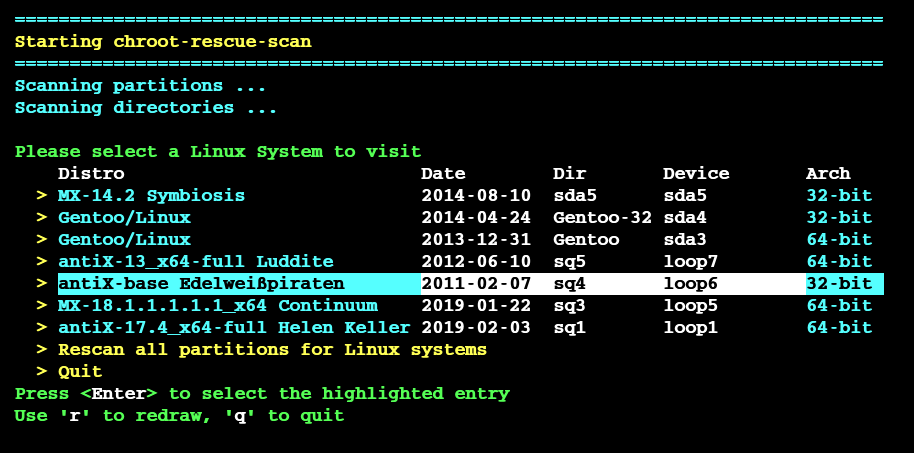These programs are meant to supplement the fehlix live rescue system. The main thing is these allow you to get into a system even if its initrd.img is broken. It also let's you get into multiple systems without rebooting.
If it has a problem identifying a Linux distro, please let me know and (ideally) show me how to correctly identify that system.
If the chroot rescue suite is not already on your system, you can quicky download the git version and start running it.
sudo apt-get update # if needed
sudo apt-get install git # if needed
git clone https://github.com/BitJam/chroot-rescue
git clone https://github.com/BitJam/cli-shell-utils
sudo chroot-rescue/bin/chroot-rescue-scan
Usage: chroot-rescue-scan [<options>]
SCAN ALL PARTITIONS for Linux systems. Mount all that are found
under the top directory (/media). Then provide a menu to chroot
into any Linux system system found under the top directory.
Options:
-C --color=<xxx> Set color scheme to off|low|low2|bw|dark|high
-d --dir=<directory> Directory to look for linux systems under
Default: /media
-h --help Show this usage
-m --menu Output menu information then exit
-s --separator=<x> Character to separate columns of data
Default: \t
-v --version Show the version number and date
Usage: chroot-rescue-select [<options>]
Look for all Linux systems under the top directory (/media).
Then provide a menu to chroot into any of the Liux systems.
Options:
-C --color=<xxx> Set color scheme to off|low|low2|bw|dark|high
-d --dir=<directory> Directory to look for linux systems under
Default: /media
-h --help Show this usage
-m --menu Output menu information then exit
-s --separator=<x> Character to separate columns of data
Default: \t
-v --version Show the version number and date
The chroot-rescue-select program will offer to chroot into any Linux file system mounted under a directory (default /media). The --scan option will cause it to mount all Linux filesystems under the directory (if they are not already mounted there).
Usage: chroot-rescue [options] <directory> [[--] <command> [<args>]]
Bind mount sys/, proc/, dev/, etc file systems and under <directory>.
Mount run/ and tmp/ as tmpfs and then chroot into that directory using
a given command or /bin/bash or /bin/sh as defaults.
If <command> is given we try to find that command under the directory
and run it in the chroot. Otherwise we look for /bin/bash and then
/bin/sh and run the first one that is found. If we find /bin/bash
this way then we create a bashrc script that gets run in order to
set the Bash prompt.
Options:
-a --add-prompt=<str> Add <str> to top of the Bash prompt
-h --help Show this help
-n --no-x Don't allow Xwindows applications to launch
-N --no-net Don't try set up networking (it still may work)
--pause Pause before normal exit
-p --pretend Don't actually execute commands
-P --prompt=<str> Use this string as the prompt
-q --quiet Only print error messages
-t --title=<str> Set the window title while in the chroot
-u --umount Umount all subdirectories of the given directory
-V --verbose Show commands that get executed
-v --version Show version and exit
Unpack and repack our live initrd file or a Debian initrd file.
Usage: unpack-initrd [options]
Unpack and repack the live initrd.gz for antiX and MX. Also unpack
and repack Debian initramfs files. Supports the following forms of
compression: bz2, gzip, lz4, lzip, lzma, xz (assuming the associated
(de)compression tool is available. Also supports microcode
preambles.
Options:
-C --clear Delete directory before unpacking
-c --compress=<prog> Use <prog> to recompress the initrd
-d --dir=<dir> Unpack in <dir> instead of ./initrd
-f --file=<file> Unpack <file> instead of:
/live/boot-dev/antiX/initrd.gz
--from=<file> Same as --file
-l --level=<N> Set compression level: 1 (fastest) -- 9 (best)
(only applies to certain compression methods)
-h --help Show this usage
-n --no-md5 Don't make a .md5 file in --repack mode
-N --no-microcode Do not repack microcode
-p --pretend Show commands without running them
-r --repack Repack the initrd file
-s --silent Only show error messages
-q --quiet Say very little
-V --verbose Show commands in addition to running them
-v --version Show the version then exit


